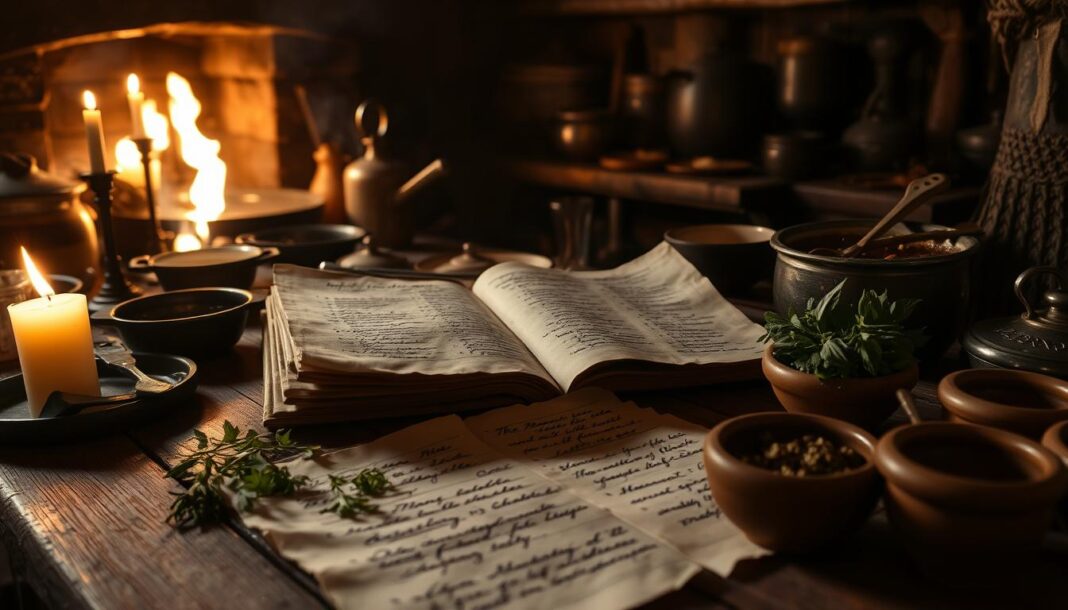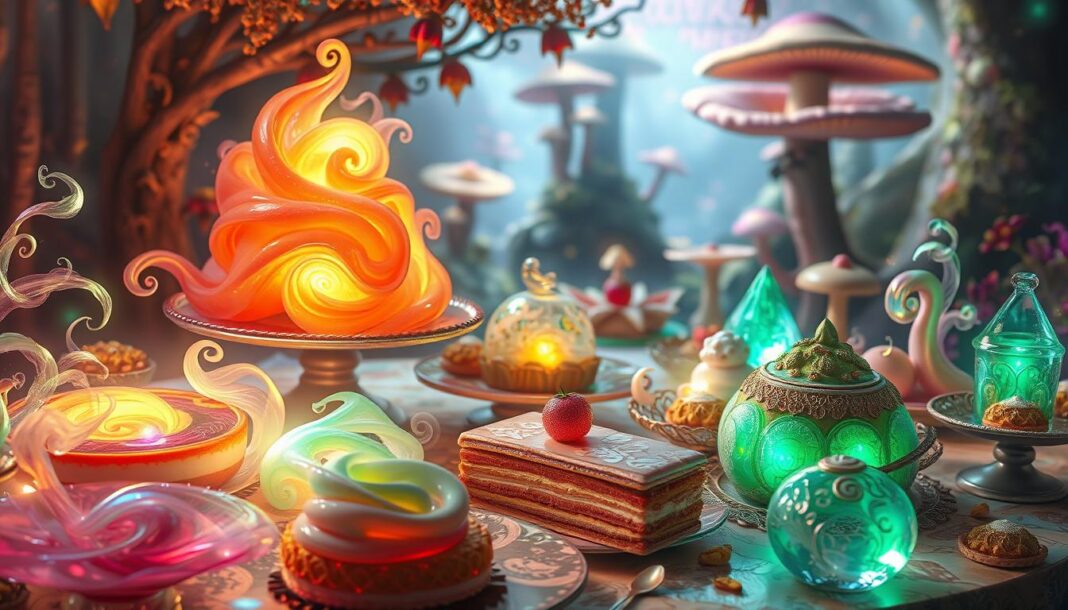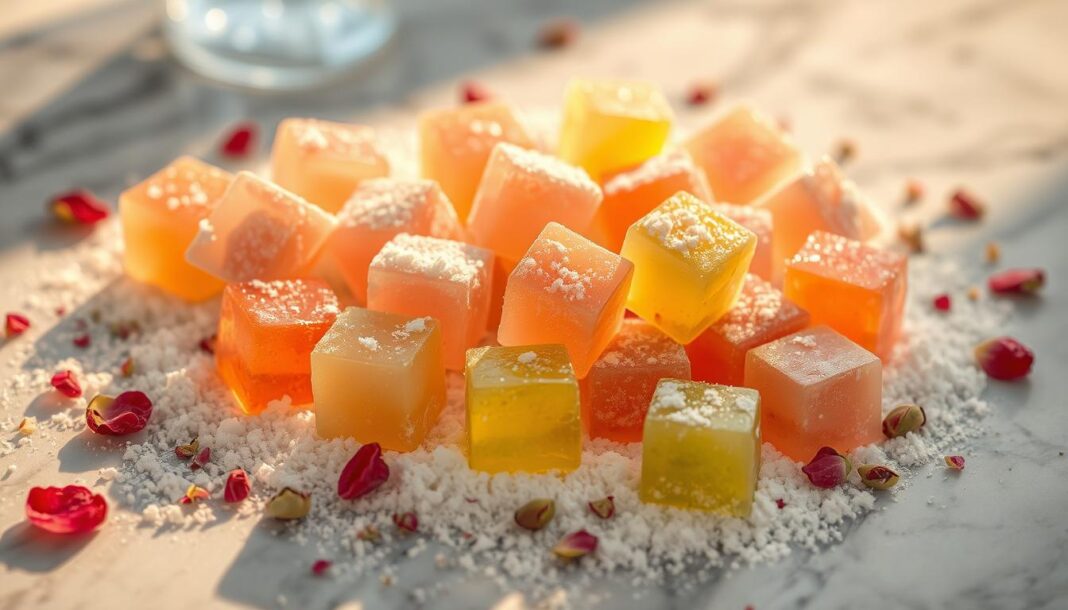The world of Westeros and Essos in Game of Thrones is not just a battleground for noble houses, but also a stage for diverse culinary traditions. As we explore the rich gastronomic landscape of this fictional universe, we discover that food plays a crucial role in shaping the narrative and cultural identity of its characters.
The show’s production team drew heavily from medieval European cuisine to create the dishes that appear on screen, often blending historical accuracy with creative liberties to serve the story. From the lavish feasts of King’s Landing to the humble fare of the Night’s Watch, the cuisine in Game of Thrones reflects the complex social hierarchies and geographical diversity of the world it portrays.
As we delve into the culinary world of Game of Thrones, we will examine the authentic medieval inspirations behind the show’s recipes and explore how they enhance our understanding of the series.
Key Takeaways
- Explore the medieval inspirations behind Game of Thrones cuisine
- Discover how food reflects the cultural and geographical diversity of Westeros and Essos
- Learn about the historical accuracy of foods portrayed in the series
- Find recipes for iconic dishes from the show that you can recreate at home
- Understand the cultural significance of food in different regions of the Game of Thrones world
The Culinary World of Westeros and Essos
The culinary world of Westeros and Essos is a reflection of the diverse climates, cultures, and histories within the Game of Thrones universe. Food plays a pivotal role in storytelling, revealing character traits, and showcasing regional identities.
Food as Storytelling in Game of Thrones
In Game of Thrones, food is not just a necessity; it’s a narrative device that highlights the richness of the world. The show’s creators paid meticulous attention to the culinary details, especially in King’s Landing, where the cuisine is opulent and colorful, featuring exotic fruits and vibrant presentation. This attention to detail reflects the capital’s wealth and access to various trade routes, setting it apart from other regions.
Regional Cuisine Differences
The diverse regions of Westeros and Essos boast unique culinary traditions. For instance, the North, centered around Winterfell, focuses on hearty, practical ingredients like stews and preserved meats, designed to sustain through harsh winters. In contrast, Dorne incorporates spicy peppers and citrus fruits, thriving in its desert climate, creating a distinctive flavor profile. The Iron Islands rely heavily on seafood due to their maritime culture, while Essos, across the Narrow Sea, features exotic culinary traditions, including the horse-based diet of the Dothraki. This variety showcases the different ways food is prepared and consumed, reflecting the local culture and ingredients available in each region, illustrating the diverse culinary way of life.
Medieval Inspiration Behind Game of Thrones Food
The world of Game of Thrones is renowned for its intricate details, and the food is no exception, drawing heavily from medieval culinary traditions. The show’s creators meticulously crafted the culinary aspects to reflect the diverse cultures and regions within the Game of Thrones universe.
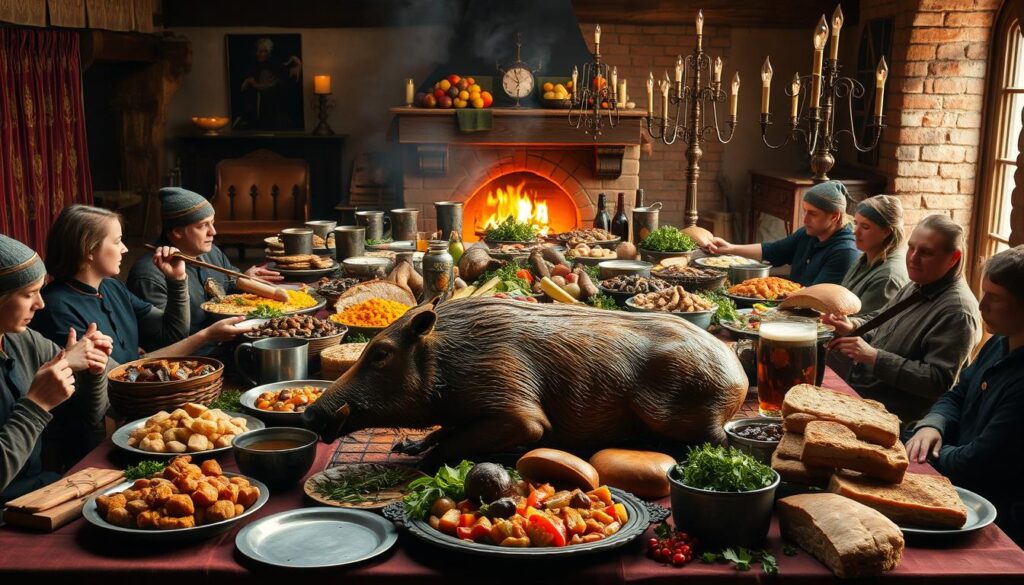
Historical Accuracy in the Show’s Cuisine
The show’s attention to historical detail is evident in its cuisine, with dishes inspired by medieval cooking methods and ingredients. For instance, the stark contrast between the cuisine in Winterfell and King’s Landing reflects the different climates and cultural influences of these regions. As noted, “Winterfell is far more basic… it’s a lot of meat, basically,” highlighting the practicality of Northern cuisine.
- The use of local ingredients and traditional cooking methods added to the authenticity of the show’s cuisine.
- Regional differences in cuisine were reflected in the show’s food styling, mirroring real medieval practices.
Set Design and Food Presentation
The presentation of food in Game of Thrones was a crucial aspect of its culinary storytelling. The production team created distinct visual styles for different regions, such as the colorful, artfully arranged dishes in King’s Landing, contrasting with the rustic, hearty presentations in Winterfell. This attention to detail in food presentation enhanced the overall viewing experience, making the world feel more immersive and real.
At one point in time, the thing that made the show stand out was its ability to make the audience feel like they were part of the world, and the food played a significant role in this.
King’s Landing: Royal Feasts and Extravagance
King’s Landing, the capital of the Seven Kingdoms, is a city where extravagant dining is an art form, reflecting the wealth and power of its rulers. The royal court spares no expense in hosting feasts that are as much about showcasing culinary prowess as they are about celebrating special occasions.
Pigeon Pie: A Royal Wedding Tradition
Pigeon Pie was a highlight at royal weddings, symbolizing love and prosperity. This dish, filled with pigeon meat and spices, was considered a delicacy. To recreate this historical dish, you can
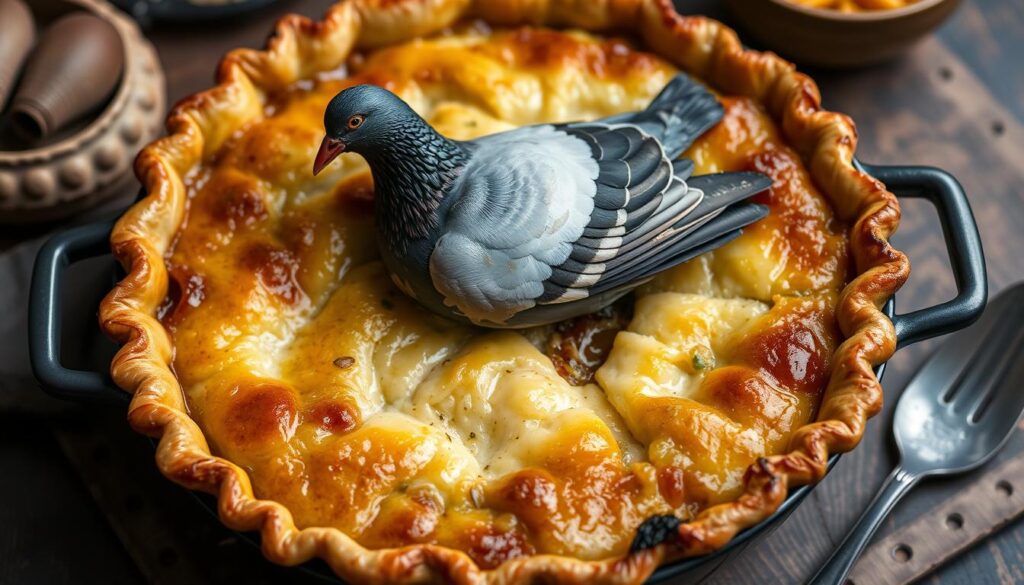
Lemon Cakes: Sansa’s Favorite Treat
Lemon cakes were a favorite of Sansa Stark, symbolizing her fascination with the refined culture of King’s Landing. These cakes, made with expensive imported lemons, represented luxury. For those interested in trying Sansa’s favorite treat, you can
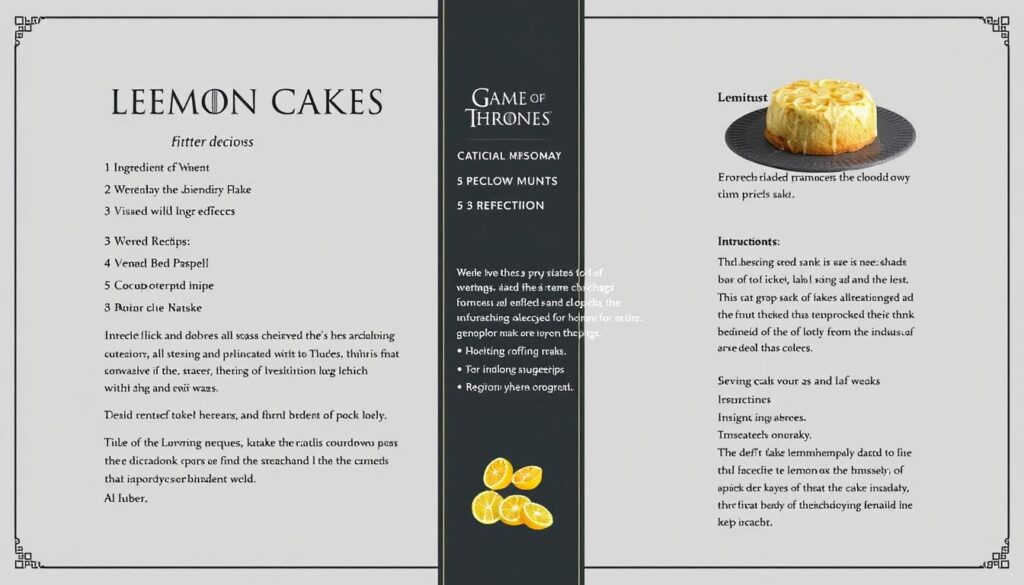
The traditional lemon cakes recipe features a light, sweet cake infused with lemon zest and juice, often topped with a tart lemon glaze or candied lemon slices, emphasizing the bright, tangy flavor that would have been considered exotic in a medieval setting.
Winterfell: Hearty Northern Fare
In the cold climate of Winterfell, the Stark family and their servants relied on robust and warming dishes. The harsh northern environment demanded meals that were not only nourishing but also capable of providing comfort against the chill.
Kidney Pie with Peas and Onions
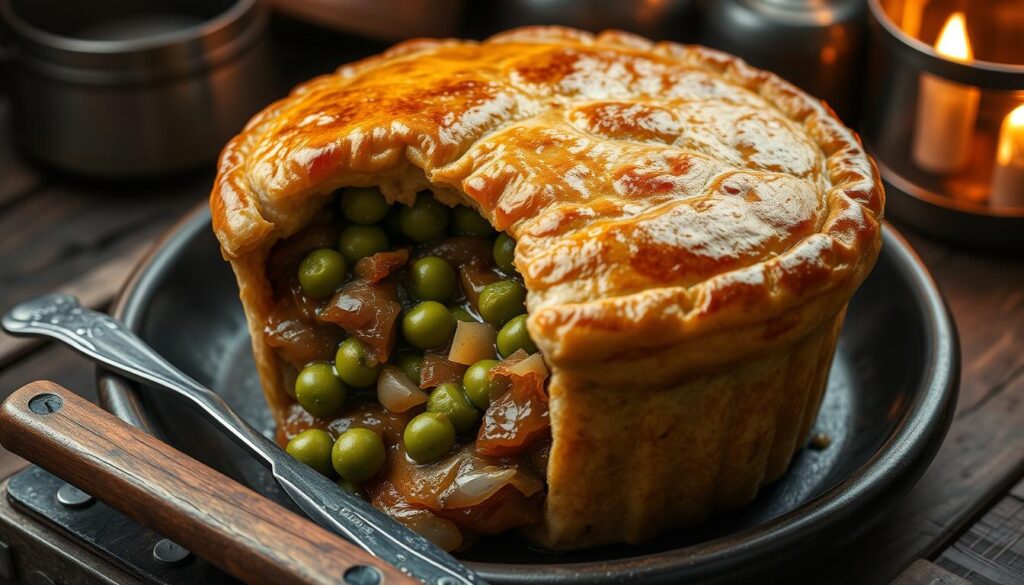
Kidney Pie with Peas and Onions is a dish that would have been familiar in the kitchens of Winterfell. This hearty pie, filled with the richness of kidneys, the sweetness of peas, and the pungency of onions, represents a meal that could sustain the inhabitants through the cold northern nights. The use of locally sourced ingredients and straightforward cooking methods made such dishes staples in northern cuisine.
Honeyed Chicken
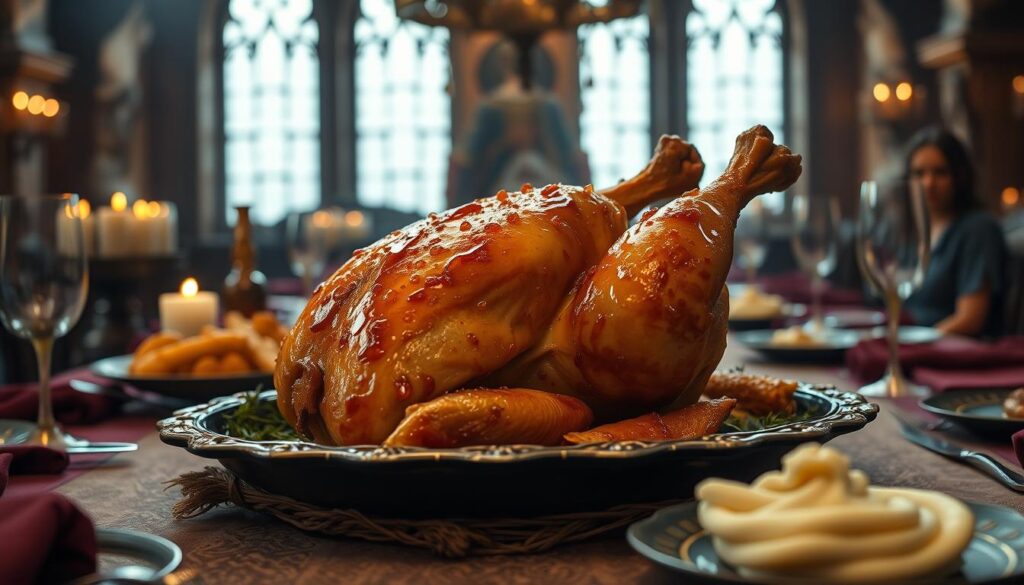
After the battle for Winterfell, Jon Snow and his men might have enjoyed honeyed chicken—a dish that embodies the North’s approach to cooking: simple ingredients transformed through slow cooking into a flavorful dish. The combination of locally available honey with chicken and herbs creates a sweet-savory balance, making it a special treat. This recipe showcases the practical yet satisfying nature of northern feasting, where even celebratory meals maintained a rustic simplicity.
The Wall: Sustenance for the Night’s Watch
The harsh environment of the Wall demanded sustenance that was both nourishing and durable for the Night’s Watch. The brothers stationed there required food that could withstand the harsh conditions and provide them with the energy needed for their duties.
Mutton Stew
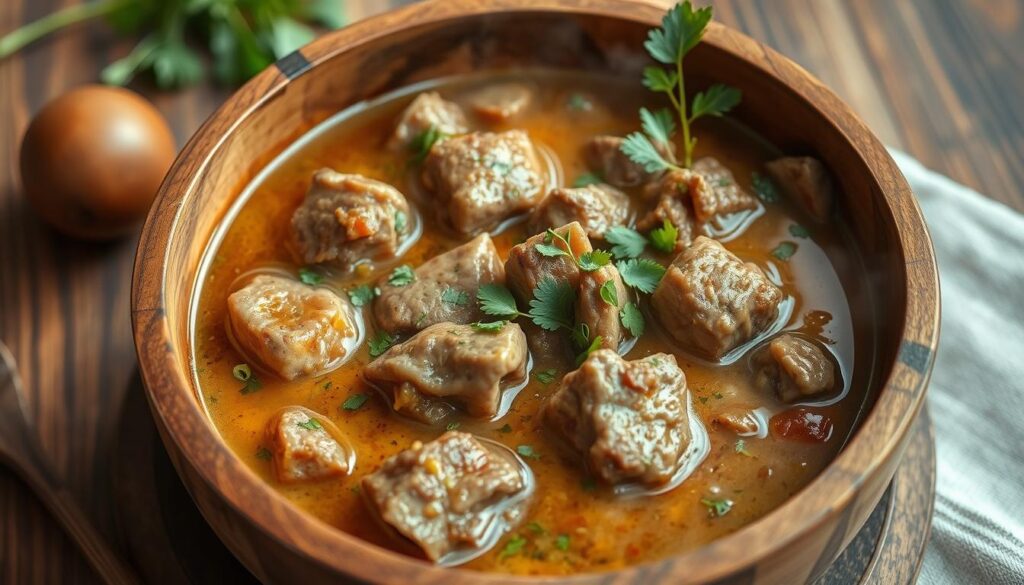
A staple of the Night’s Watch was mutton stew, a simple yet nourishing dish made with readily available ingredients. This hearty stew was a mainstay, providing warmth and sustenance to the brothers. To recreate this dish, one can follow a simple game of thrones mutton stew recipe that involves slow-cooking mutton with vegetables and broth.
Black Bread
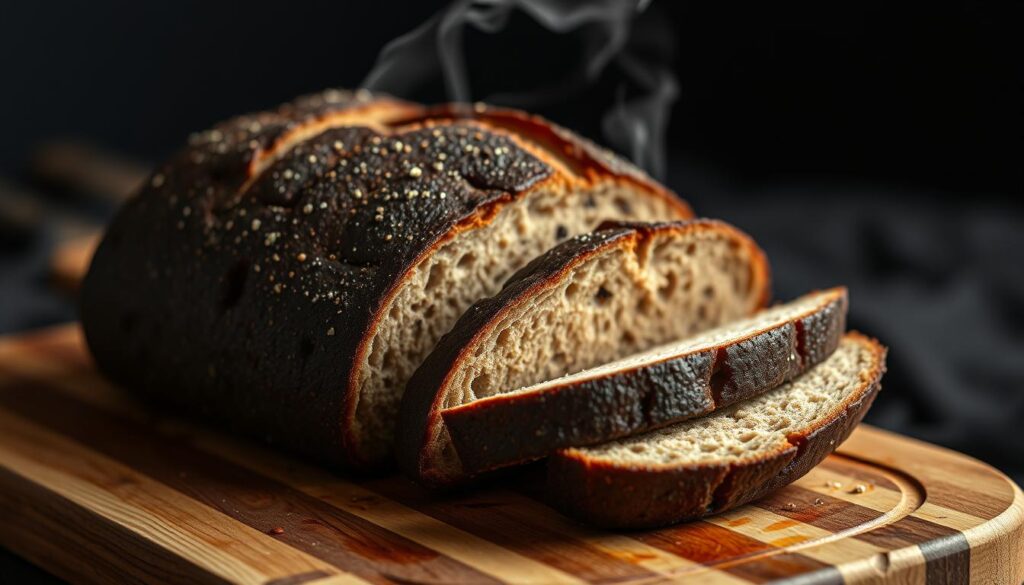
Black bread was another staple at Castle Black, serving as a dense and filling food source for the Night’s Watch. Made with rye flour and sometimes dark beer, this bread had a distinctive flavor and excellent keeping qualities. The dense texture and minimal leavening made it ideal for pairing with the Watch’s perpetual stews. Jon Snow and his fellow brothers relied on this bread during their missions beyond the Wall. We can make this bread by following a simple game of thrones black bread recipe, which involves mixing rye flour, dark beer, and minimal leavening, then baking until dense and dark.
The Iron Islands: Seafood Specialties
The Iron Islands, known for their harsh maritime culture, have a surprisingly rich culinary tradition. Their cuisine is characterized by an abundance of seafood, reflecting their seafaring lifestyle. The Ironborn people have developed unique dishes that not only showcase their culinary skills but also embody their practical, no-waste approach to food.
One of the standout dishes from this region is Sister’s Stew, a hearty fish stew that has gained fame throughout Westeros for its flavor and heartiness.
Sister’s Stew in Bread Trenchers
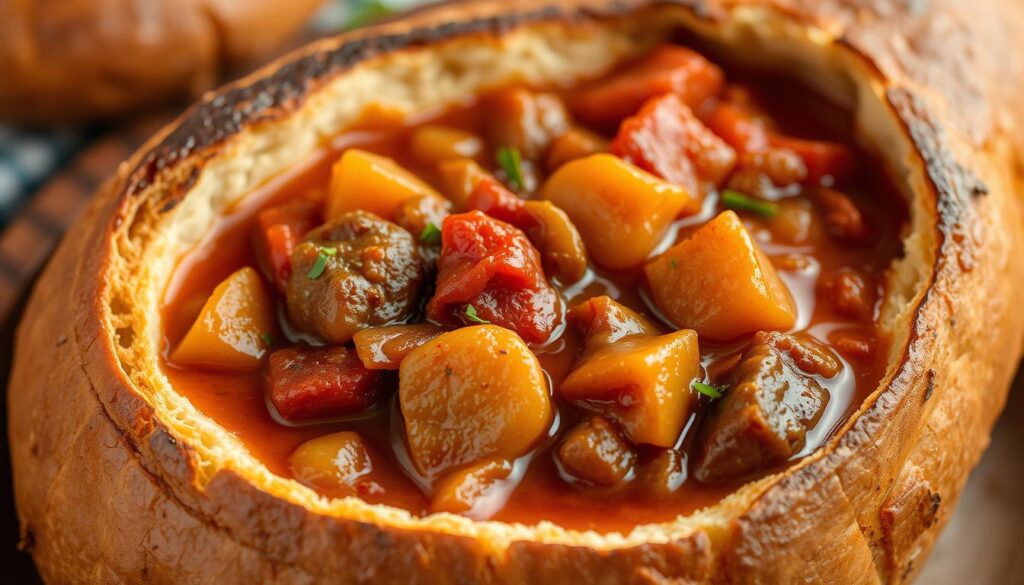
Sister’s Stew epitomizes Iron Islands cuisine, combining the region’s abundant seafood resources with their practical approach to cooking. This stew typically contains various types of fish and seafood, including crab, white fish, and shellfish, simmered in a rich broth enriched with onions, cream, and herbs.
The traditional serving method for Sister’s Stew is particularly noteworthy. It’s served in a “trencher” – a hollowed-out loaf of stale bread that functions as an edible bowl. This method exemplifies the waste-nothing approach of the Iron Islands culture.
The stew‘s rich, creamy texture provides necessary calories for the seafaring Ironborn, while its high salt content helps preserve the dish for longer periods. Despite the Iron Islands’ reputation for a harsh culture, Sister’s Stew represents one of their celebrated culinary achievements.
Dorne: Spicy Southern Cuisine
In the world of Game of Thrones, Dorne stands out for its distinctive culinary traditions, marked by the use of hot peppers and spices. The region’s cuisine is shaped by its Mediterranean and North African influences, resulting in bold and flavorful dishes.
Dorne’s hot climate allows for the cultivation of a variety of peppers and spices that are not found in the cooler northern regions of Westeros. This has led to the development of a unique culinary tradition that is characterized by its bold use of heat and flavor.
Stuffed Dragon Peppers
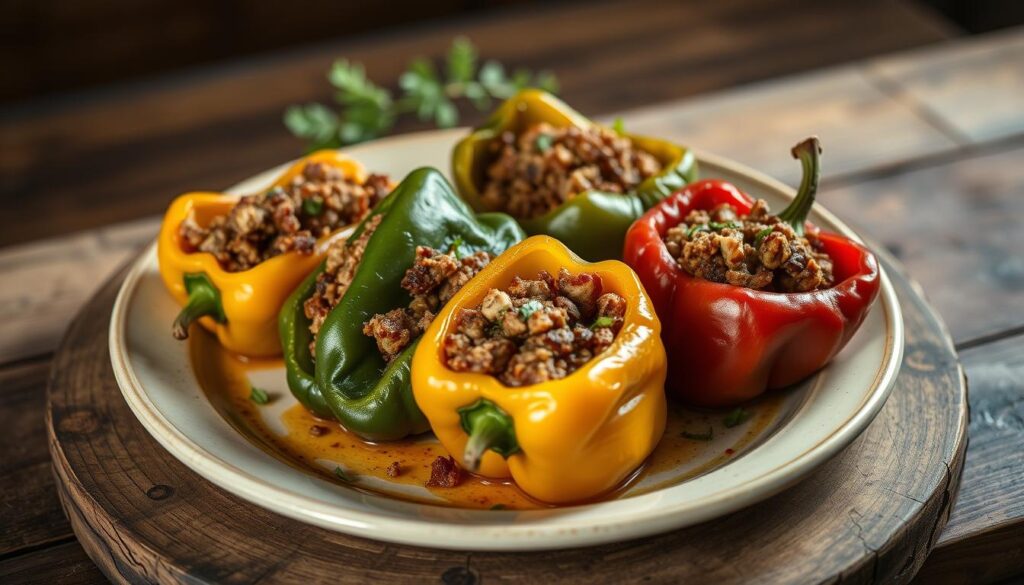
One of the most iconic Dornish dishes is the stuffed dragon pepper, a recipe that combines the fiery heat of the peppers with cooling elements like cheese. To make this dish, we smoked cream cheese and mixed it with yellow cheese and onions, then stuffed it into Hungarian hot peppers before smoking to perfection.
The preparation method of smoking both the cheese filling and the stuffed peppers adds complexity to the dish, reflecting the more elaborate cooking techniques available in Dorne’s stable climate. This recipe showcases the sophistication and boldness of Dornish cuisine, making it a standout in the world of Game of Thrones.
The use of spices and heat in this dish symbolizes the Dornish people themselves: fiery, bold, and distinctly different from the rest of the Seven Kingdoms in both culture and temperament.
Flea Bottom: Humble Street Food
Among the crowded and unsanitary alleys of Flea Bottom, a peculiar stew known as the ‘Bowl of Brown’ became a staple for the impoverished residents. This dish, made from whatever scraps of meat were available, often included cat, pigeon, or rat, and was simmered for extended periods.
Bowl of Brown
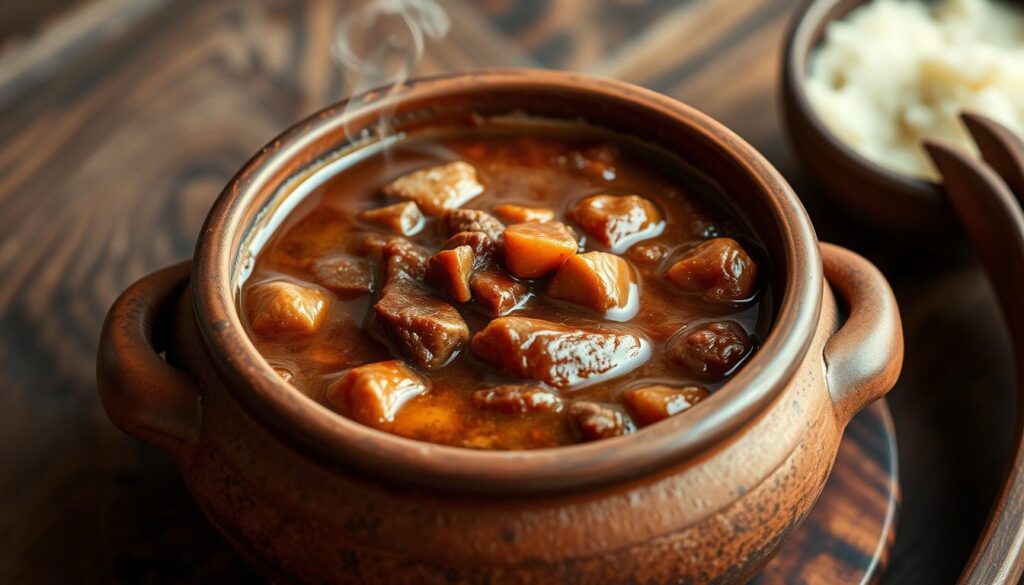
The ‘Bowl of Brown’ was more than just a meal; it represented the desperate subsistence of King’s Landing’s poorest residents. This perpetual stew, which could cook for years with ingredients being added as needed, exemplified the stark class divisions within the capital. The long cooking process made even questionable meats edible, while the dark brown color disguised the exact contents.
For characters like Gendry and Davos, who grew up in Flea Bottom, the ‘Bowl of Brown’ symbolized their humble origins and the harsh realities of commoner life in Westeros. Despite being unappetizing by noble standards, this stew provided crucial protein and calories to the urban poor who lacked access to fresh ingredients and cooking facilities.
Across the Narrow Sea: Essos Delicacies
The world of Essos, as depicted in Game of Thrones, offers a diverse array of delicacies that reflect the region’s rich cultural heritage. The cuisine here is shaped by various cultures, including the Dothraki, known for their nomadic traditions and meat-centric diet.
Dothraki Dried Horse Jerky
The Dothraki people are known for their love of horse meat, often dried or cooked over an open fire. Dried horse jerky is a staple in their diet, providing sustenance for their warriors as they traverse the vast steppes. This dried meat is rich in protein and is often consumed during long journeys or battles.
Stallion Heart
The raw stallion heart is one of the most memorable food scenes in Game of Thrones, showcasing Daenerys Targaryen’s ritual consumption to prove her strength to the Dothraki. This ceremonial food carries immense cultural significance, as it is believed to ensure the strength and ferocity of a khaleesi’s unborn child. The production team created a realistic prop using solidified jam and gelatin, colored to resemble raw meat. Consuming the heart was a challenge due to its bitter taste and chewy texture, symbolizing Daenerys’ transformation into a true Khaleesi. This act took considerable time and courage, reflecting her commitment to embracing Dothraki customs.
Game of Thrones Food Recreated: Iconic Recipes
From the direwolf bread to the infamous Frey Pie, we’re exploring the most intriguing recipes from the Game of Thrones universe. These dishes not only tantalize our taste buds but also offer a glimpse into the rich culinary history of Westeros.
Hot Pie’s Direwolf Bread

Hot Pie’s Direwolf Bread is a simple yet hearty recipe that would have been a staple in the harsh winters of the North. We can recreate this bread using traditional medieval ingredients and techniques, focusing on a robust crust and dense texture.
Frey Pie

The Frey Pie represents one of the darkest moments in Game of Thrones, symbolizing Arya’s vengeance. For our recipe, we’ll substitute the original filling with game meats like rabbit or venison, wrapped in a hot water crust pastry. This traditional recipe requires patience and skill, but the result is a rich, savory pie that’s both a tribute to the show and a delicious meal.
Sweet Treats from the Seven Kingdoms
The sweetest moments in Game of Thrones often involve the delightful array of desserts and pastries found throughout the Seven Kingdoms. These sweet treats not only tantalize the taste buds but also play a significant role in the show’s culinary culture.
Honey Cakes
Honey cakes are a beloved treat in Westeros, often served at feasts and celebrations. We find that a simple recipe involving honey, flour, and eggs can recreate this delightful dessert. To make honey cakes, one must carefully mix the ingredients and bake them to perfection.
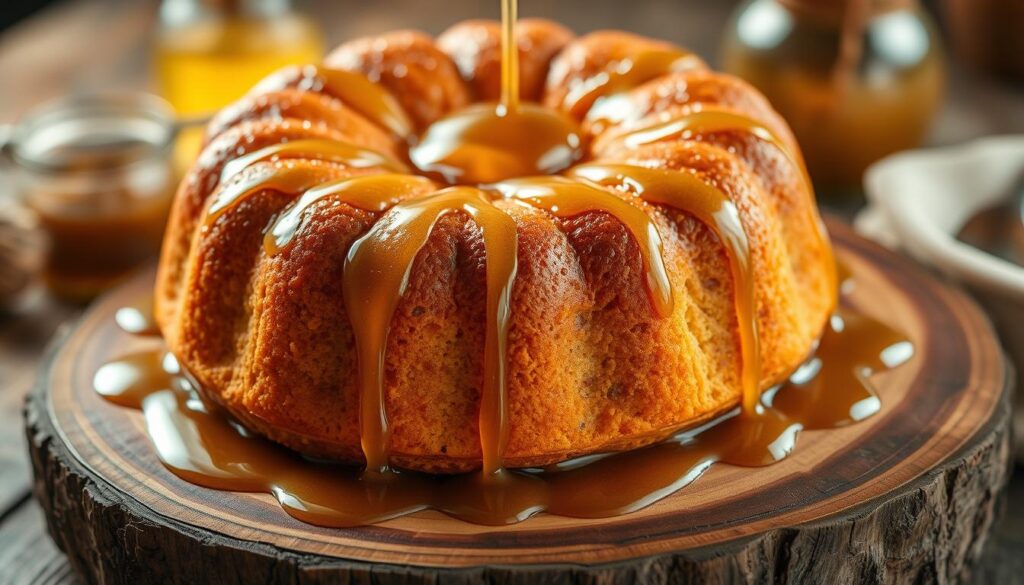
Candied Plums and Almonds
Candied fruits and nuts, such as plums and almonds, represent luxury sweets in Westeros, typically served at high-born feasts. The process of candying involves coating the fruits or nuts in multiple layers of honey or sugar syrup, creating a sweet and crunchy exterior. This treat was especially valuable during winter, as it allowed seasonal fruits to be enjoyed year-round.
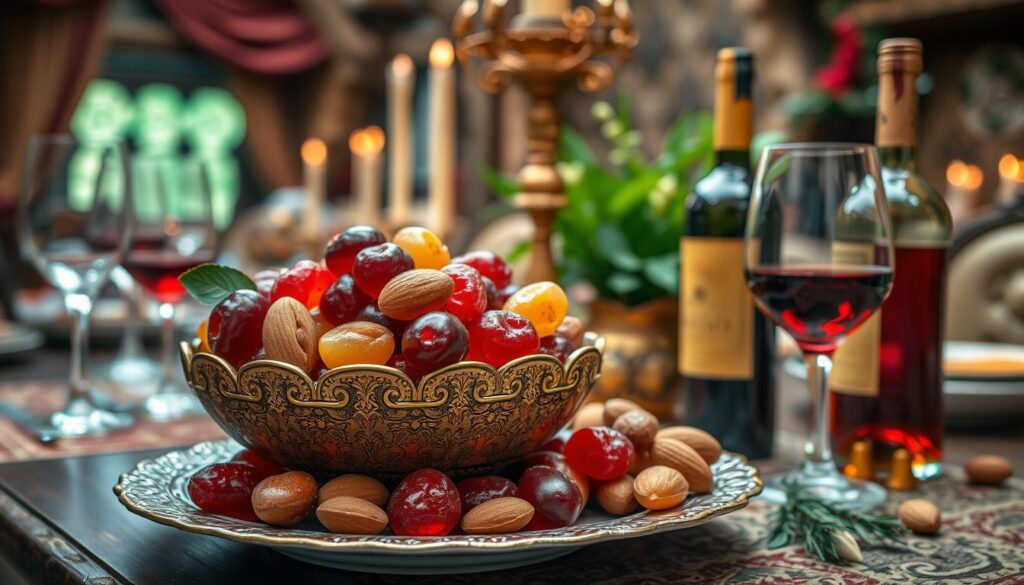
Wines and Beverages of Westeros
Westeros is renowned for its rich variety of wines and drinks, reflecting the diverse cultures across the Seven Kingdoms. The nobility and aristocracy often favor fine wines, while common folk tend to consume ales and beers.
Arbor Gold and Dornish Red
The Reach is famous for its Arbor Gold, a high-quality wine often served at royal feasts and special occasions. In contrast, Dorne is known for its Dornish Red, a robust wine that pairs well with spicy dishes. Wine plays a significant role in the aristocratic drinking culture of Westeros, with different regions producing unique varieties.
Ale, Mead, and Other Drinks
Ale is a staple drink among the common people, brewed locally with varying quality and strength. Mead, a fermented honey drink, is particularly popular in the North and among the wildlings. The Night’s Watch relies heavily on ale and rough wines for sustenance and morale. Other distinctive drinks include fermented goat’s milk and strong spirits consumed by the wildlings beyond the Wall.
| Beverage | Region | Description |
|---|---|---|
| Arbor Gold | The Reach | High-quality wine served at royal feasts |
| Dornish Red | Dorne | Robust wine pairing well with spicy dishes |
| Ale | Throughout Westeros | Locally brewed beverage for common folk |
| Mead | The North and wildlings | Fermented honey drink, potent and popular |
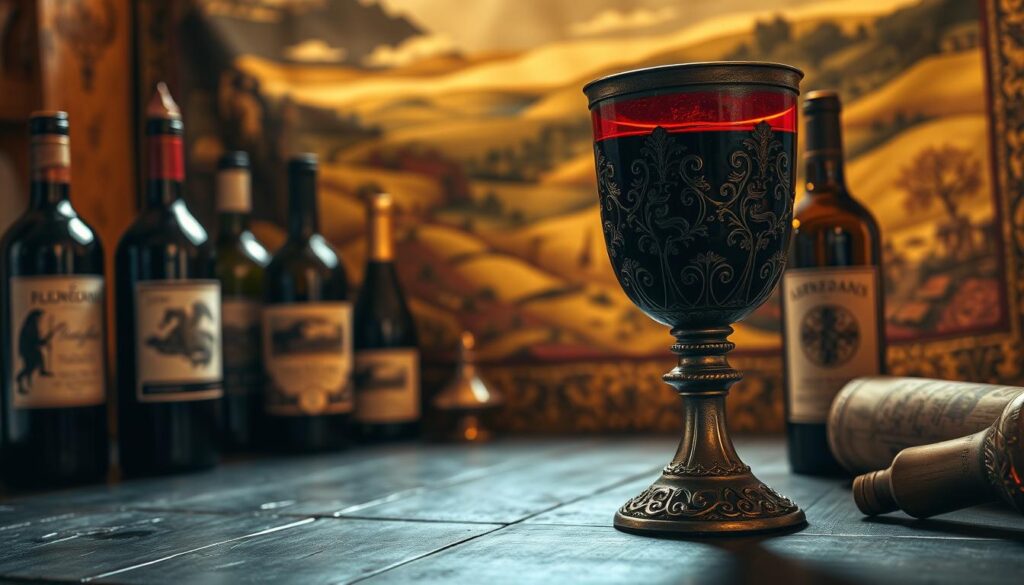
Feasting Like a Lannister: Opulent Dining
In the world of Game of Thrones, feasting like a Lannister is an art form that embodies opulence and extravagance. The Lannisters, known for their wealth and power, spare no expense in their culinary indulgences, reflecting their status in the lavish feasts they host.
Gold-Crusted Roasts
The Lannisters’ love for luxury is evident in their dishes, such as gold-crusted roasts that are as visually stunning as they are delicious. These roasts, often made with the finest meats available in Westeros, are cooked to perfection and then adorned with a layer of gold leaf, symbolizing the wealth and prestige of the Lannister family.
Cersei’s Wine and Fruit Platters
Cersei Lannister’s preference for fine wines and exotic fruits is well-documented. Her wine selections typically feature Arbor Gold and other premium vintages, served in ornate golden goblets. Fruit platters in King’s Landing would showcase imported luxuries like blood oranges from Dorne, pomegranates, and figs, items that are not only rare but also serve as powerful status symbols.
| Dish | Description | Symbolism |
|---|---|---|
| Gold-Crusted Roasts | Roasts made with fine meats and adorned with gold leaf | Wealth and prestige of the Lannister family |
| Cersei’s Wine | Fine wines such as Arbor Gold served in golden goblets | Lannister wealth and status |
| Fruit Platters | Exotic fruits like blood oranges, pomegranates, and figs | Status symbol due to the rarity and import of the fruits |
The Night King’s Influence: Themed Cocktails
The Night King’s influence extends beyond the screen, inspiring creative cocktails that capture the essence of the White Walkers. As fans of Game of Thrones, we’re drawn to the show’s intricate world-building, including its culinary and mixological elements.
Blue “White Walker” Cocktail
The Blue “White Walker” cocktail is a fan-favorite, embodying the icy, otherworldly presence of the White Walkers. This striking blue beverage typically combines UV Blue vodka, raspberry sherbet, and lemon-lime soda to create a refreshing, yet potent drink.
The recipe is simple: mix 1.5 oz of UV Blue vodka with 1 oz of raspberry sherbet and top it off with lemon-lime soda. The result is a drink that’s as visually stunning as it is potent, making it a great addition to any Game of Thrones viewing party.
- The Blue “White Walker” cocktail represents a modern, fan-created tribute to the show’s iconic villains, using color and presentation to evoke the eerie blue eyes of the undead.
- This striking blue beverage typically combines white spirits like vodka with blue curaçao liqueur and sometimes coconut cream to create the distinctive color and icy appearance.
- Presentation elements often include sugar-frosted glass rims, dry ice for a foggy effect, and blue LED ice cubes that enhance the supernatural aesthetic.
- The cocktail’s flavor profile balances sweetness with a strong alcoholic punch, creating a memorable drink that’s become a staple at Game of Thrones viewing parties.
- While not canon to the show’s world, these themed cocktails demonstrate how fans have extended the Game of Thrones experience into real-world entertaining, creating immersive experiences around the series.
Hosting Your Own Game of Thrones Feast
Hosting a Game of Thrones feast is an exciting way to combine food, atmosphere, and fandom, creating an unforgettable experience for your guests. To make it truly memorable, attention to detail is key.
Menu Planning by Region
When planning your feast, consider drawing inspiration from the different regions of Westeros and Essos. Each area has its unique culinary traditions, from the hearty Northern fare of Winterfell to the spicy cuisine of Dorne. Create a menu that reflects this diversity, incorporating dishes such as Kidney Pie with Peas and Onions or Stuffed Dragon Peppers.
Themed Decorations and Presentation
To enhance the immersive quality of your Game of Thrones feast, focus on themed decorations and presentation. Use wooden trenchers or rustic pottery, and decorate with house banners, candles, and rustic table settings. Serving dishes in bread bowls, arranging meat on wooden boards, and using goblets instead of glasses will further enrich the experience. Playing music from the show’s soundtrack in the background will complete the atmosphere, making the evening a memorable one in a truly way that honors the spirit of the series.
The Legacy of Game of Thrones Through Its Food
The detailed food culture of Game of Thrones has not only enhanced the viewing experience but has also had a profound influence on food enthusiasts worldwide. The show’s culinary world has inspired a plethora of cookbooks, themed restaurants, and home cooks to explore medieval cuisine, recreating iconic recipes from the series.
The attention to regional food differences has educated viewers on how cuisine reflects geography, climate, and culture, both in Westeros and our own world. As a result, people are now more inclined to explore historical cooking techniques and medieval recipes, fostering a deeper appreciation for the culinary arts. Over time, the legacy of Game of Thrones will continue to be felt, with its influence on food culture enduring long after the series conclusion.
